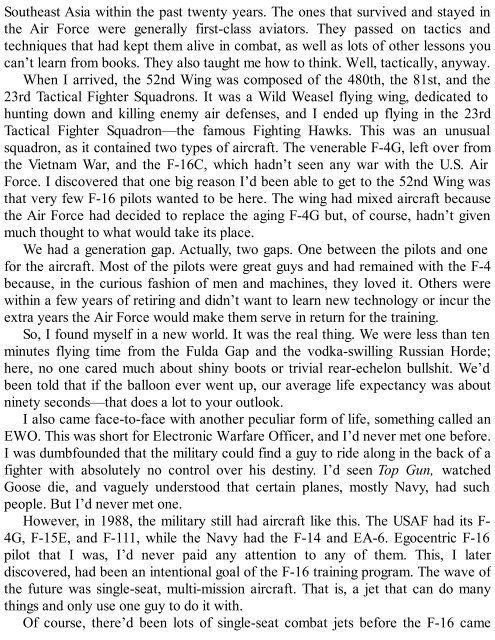You also want an ePaper? Increase the reach of your titles
YUMPU automatically turns print PDFs into web optimized ePapers that Google loves.
Southeast Asia within the past twenty years. The ones that survived and stayed in<br />
the Air Force were generally first-class aviators. They passed on tactics and<br />
techniques that had kept them alive in combat, as well as lots of other lessons you<br />
can’t learn from books. They also taught me how to think. Well, tactically, anyway.<br />
When I arrived, the 52nd Wing was composed of the 480th, the 81st, and the<br />
23rd Tactical Fighter Squadrons. It was a Wild Weasel flying wing, dedicated to<br />
hunting down and killing enemy air defenses, and I ended up flying in the 23rd<br />
Tactical Fighter Squadron—the famous Fighting Hawks. This was an unusual<br />
squadron, as it contained two types of aircraft. The venerable F-4G, left over from<br />
the Vietnam War, and the F-16C, which hadn’t seen any war with the U.S. Air<br />
Force. I discovered that one big reason I’d been able to get to the 52nd Wing was<br />
that very few F-16 pilots wanted to be here. The wing had mixed aircraft because<br />
the Air Force had decided to replace the aging F-4G but, of course, hadn’t given<br />
much thought to what would take its place.<br />
We had a generation gap. Actually, two gaps. One between the pilots and one<br />
for the aircraft. Most of the pilots were great guys and had remained with the F-4<br />
because, in the curious fashion of men and machines, they loved it. Others were<br />
within a few years of retiring and didn’t want to learn new technology or incur the<br />
extra years the Air Force would make them serve in return for the training.<br />
So, I found myself in a new world. It was the real thing. We were less than ten<br />
minutes flying time from the Fulda Gap and the vodka-swilling Russian Horde;<br />
here, no one cared much about shiny boots or trivial rear-echelon bullshit. We’d<br />
been told that if the balloon ever went up, our average life expectancy was about<br />
ninety seconds—that does a lot to your outlook.<br />
I also came face-to-face with another peculiar form of life, something called an<br />
EWO. This was short for Electronic Warfare Officer, and I’d never met one before.<br />
I was dumbfounded that the military could find a guy to ride along in the back of a<br />
fighter with absolutely no control over his destiny. I’d seen Top Gun, watched<br />
Goose die, and vaguely understood that certain planes, mostly Navy, had such<br />
people. But I’d never met one.<br />
However, in 1988, the military still had aircraft like this. The USAF had its F-<br />
4G, F-15E, and F-111, while the Navy had the F-14 and EA-6. Egocentric F-16<br />
pilot that I was, I’d never paid any attention to any of them. This, I later<br />
discovered, had been an intentional goal of the F-16 training program. The wave of<br />
the future was single-seat, multi-mission aircraft. That is, a jet that can do many<br />
things and only use one guy to do it with.<br />
Of course, there’d been lots of single-seat combat jets before the F-16 came
















